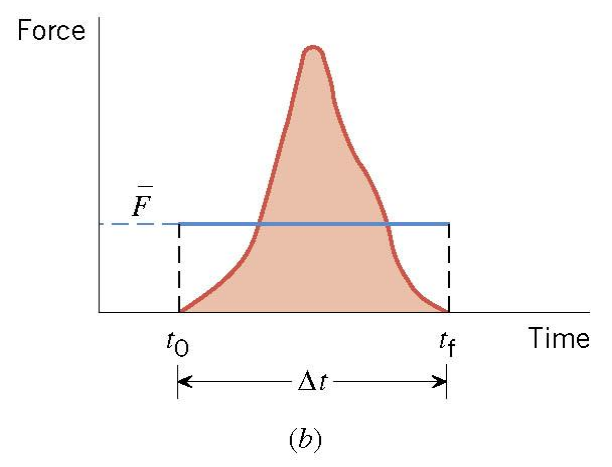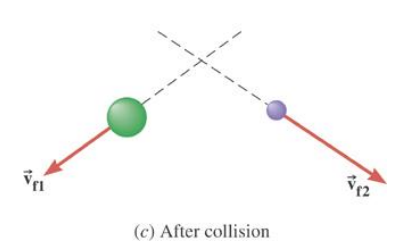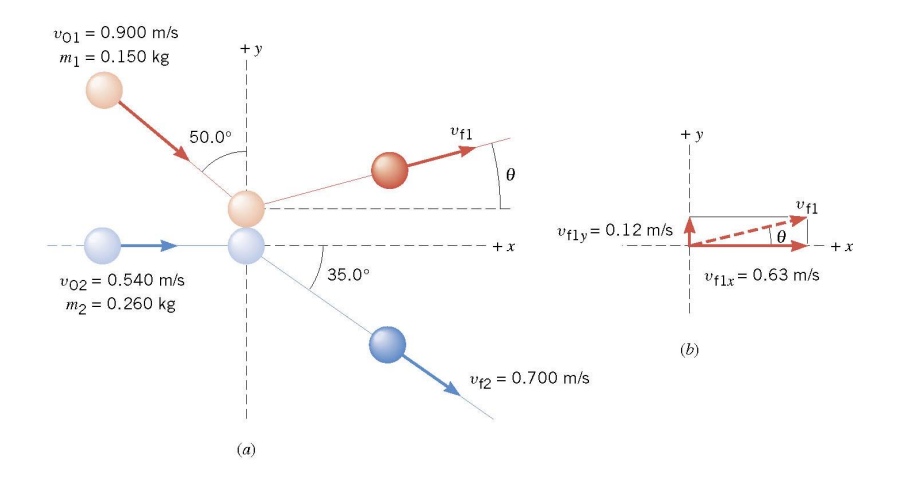- IB DP Physics 2025 SL- IB Style Practice Questions with Answer-Topic Wise-Paper 1
- IB DP Physics 2025 HL- IB Style Practice Questions with Answer-Topic Wise-Paper 1
- IB DP Physics 2025 SL- IB Style Practice Questions with Answer-Topic Wise-Paper 2
- IB DP Physics 2025 HL- IB Style Practice Questions with Answer-Topic Wise-Paper 2
7.1 The Impulse-Momentum Theorem


There are many situations when the force on an object is not constant.
DEFINITION OF IMPULSE
The impulse of a force is the product of the average force and the time interval during which the force acts:
$
\overrightarrow{\mathbf{J}}=\overline{\overrightarrow{\mathbf{F}}} \Delta t
$
Impulse is a vector quantity and has the same direction as the average force.
newton \(\cdot\) seconds \((\mathrm{N} \cdot \mathrm{s})\)

\(\overrightarrow{\mathbf{J}}=\overline{\overrightarrow{\mathbf{F}}} \Delta t\)
DEFINITION OF LINEAR MOMENTUM
The linear momentum of an object is the product of the object’s mass times its velocity:
$
\overrightarrow{\mathbf{p}}=m \overrightarrow{\mathbf{v}}
$
Linear momentum is a vector quantity and has the same direction as the velocity.
kilogram \(\cdot\) meter \(/ \mathrm{second}(\mathrm{kg} \cdot \mathrm{m} / \mathrm{s})\)

\(\overline{\overrightarrow{\mathbf{a}}}=\frac{\overrightarrow{\mathbf{v}}_{\mathbf{f}}-\overrightarrow{\mathbf{v}}_{\mathbf{0}}}{\Delta t}\)
\(\sum \overline{\overrightarrow{\mathbf{F}}}=m \overline{\overrightarrow{\mathbf{a}}}\)
\(\begin{aligned} & \sum \overline{\overrightarrow{\mathbf{F}}}=\frac{m \overrightarrow{\mathbf{v}}_{\mathbf{f}}-m \overrightarrow{\mathbf{v}}_{\mathbf{0}}}{\Delta t} \\ & \left(\sum \overline{\overrightarrow{\mathbf{F}}}\right) \Delta t=m \overrightarrow{\mathbf{v}}_{\mathbf{f}}-m \overrightarrow{\mathbf{v}}_{\mathbf{o}}\end{aligned}\)
IMPULSE-MOMENTUM THEOREM
When a net force acts on an object, the impulse of this force is equal to the change in the momentum of the object

Example 2 A Rain Storm
Rain comes down with a velocity of \(-15 \mathrm{~m} / \mathrm{s}\) and hits the roof of a car. The mass of rain per second that strikes the roof of the car is \(0.060 \mathrm{~kg} / \mathrm{s}\). Assuming that rain comes to rest upon striking the car, find the average force exerted by the rain on the roof.

\(\left(\sum \overrightarrow{\overrightarrow{\mathbf{F}}}\right) \Delta t=m \overrightarrow{\mathbf{v}}_{\mathbf{f}}-m \overrightarrow{\mathbf{v}}_{\mathbf{o}}\)

Neglecting the weight of the raindrops, the net force on a raindrop is simply the force on the raindrop due to the roof.
\(\overline{\overrightarrow{\mathbf{F}}} \Delta t=m \overrightarrow{\mathbf{v}}_{\mathbf{f}}-m \overrightarrow{\mathbf{v}}_{\mathbf{o}}\)
\(\overline{\overrightarrow{\mathbf{F}}}=-\left(\frac{m}{\Delta t}\right) \overrightarrow{\mathbf{v}}_{\mathbf{o}}\)
\(\overline{\overrightarrow{\mathbf{F}}}=-(0.060 \mathrm{~kg} / \mathrm{s})(-15 \mathrm{~m} / \mathrm{s})=+0.90 \mathrm{~N}\)
Conceptual Example 3 Hailstones Versus Raindrops
Instead of rain, suppose hail is falling. Unlike rain, hail usually bounces off the roof of the car.
If hail fell instead of rain, would the force be smaller than, equal to, or greater than that calculated in Example 2?

7.2 The Principle of Conservation of Linear Momentum
WORK-ENERGY THEOREM \(\Leftrightarrow\) CONSERVATION OF ENERGY
IMPULSE-MOMENTUM THEOREM \(\Leftrightarrow\) ???
Apply the impulse-momentum theorem to the midair collision between two objects…..


Internal forces – Forces that objects within the system exert on each other.
External forces – Forces exerted on objects by agents external to the system.
$
\left(\sum \overrightarrow{\mathbf{F}}\right) \Delta t=m \overrightarrow{\mathbf{v}}_{\mathbf{f}}-m \overrightarrow{\mathbf{v}}_{\mathbf{o}}
$
OBJECT
$
\left(\overrightarrow{\mathbf{W}}_1+\overrightarrow{\mathbf{F}}_{12}\right) \Delta t=m_1 \overrightarrow{\mathbf{v}}_{\mathbf{f} 1}-m_1 \overrightarrow{\mathbf{v}}_{\mathbf{o} 1}
$
OBJECT 2
$
\left(\overrightarrow{\mathbf{W}}_2+\overrightarrow{\overrightarrow{\mathbf{F}}}_{21}\right) \Delta t=m_2 \overrightarrow{\mathbf{v}}_{\mathbf{f} 2}-m_2 \overrightarrow{\mathbf{v}}_{\mathbf{0} 2}
$


\(\begin{aligned}\left(\overrightarrow{\mathbf{W}}_1+\overrightarrow{\overrightarrow{\mathbf{F}}}_{12}\right) \Delta t & =m_1 \overrightarrow{\mathbf{v}}_{\mathbf{f} 1}-m_1 \overrightarrow{\mathbf{v}}_{\mathbf{o} 1} \\ & + \\ \left(\overrightarrow{\mathbf{W}}_2+\overrightarrow{\overrightarrow{\mathbf{F}}}_{21}\right) \Delta t & =m_2 \overrightarrow{\mathbf{v}}_{\mathbf{f} 2}-m_2 \overrightarrow{\mathbf{v}}_{\mathbf{0} 2}\end{aligned}\)



The internal forces cancel out.
$
\left(\overrightarrow{\mathbf{W}}_1+\overrightarrow{\mathbf{W}}_2\right) \Delta t=\overrightarrow{\mathbf{P}}_{\mathbf{f}}-\overrightarrow{\mathbf{P}}_{\mathbf{o}}
$
(sum of average external forces) \(\Delta t=\overrightarrow{\mathbf{P}}_{\mathbf{f}}-\overrightarrow{\mathbf{P}}_{\mathbf{o}}\)
(sum of average external forces) \(\Delta t=\overrightarrow{\mathbf{P}}_{\mathbf{f}}-\overrightarrow{\mathbf{P}}_{\mathbf{o}}\)
If the sum of the external forces is zero, then
$
0=\overrightarrow{\mathbf{P}}_{\mathbf{f}}-\overrightarrow{\mathbf{P}}_{\mathbf{o}} \Longrightarrow \overrightarrow{\mathbf{P}}_{\mathbf{f}}=\overrightarrow{\mathbf{P}}_{\mathbf{o}}
$
PRINCIPLE OF CONSERVATION OF LINEAR MOMENTUM
The total linear momentum of an isolated system is constant (conserved). An isolated system is one for which the sum of the average external forces acting on the system is zero.
Conceptual Example 4 Is the Total Momentum Conserved?

Imagine two balls colliding on a billiard table that is friction-free. Use the momentum conservation principle in answering the following questions. (a) Is the total momentum of the two-ball system the same before and after the collision? (b) Answer part (a) for a system that contains only one of the two colliding balls.
PRINCIPLE OF CONSERVATION OF LINEAR MOMENTUM

The total linear momentum of an isolated system is constant (conserved). An isolated system is one for which the sum of the average external forces acting on the system is zero.
In the top picture the net external force on the system is zero.
In the bottom picture the net external force on the system is not zero.
Example 6 Ice Skaters

Starting from rest, two skaters push off against each other on ice where friction is negligible.
One is a \(54-\mathrm{kg}\) woman and one is a 88-kg man. The woman moves away with a speed of \(+2.5 \mathrm{~m} / \mathrm{s}\). Find the recoil velocity of the man.
▶️Answer/Explanation
Ans:

\(\begin{gathered}\overrightarrow{\mathbf{P}}_{\mathbf{f}}=\overrightarrow{\mathbf{P}}_{\mathbf{o}} \\ m_1 v_{f 1}+m_2 v_{f 2}=0 \\ v_{f 2}=-\frac{m_1 v_{f 1}}{m_2}\end{gathered}\)
\(v_{f 2}=-\frac{(54 \mathrm{~kg})(+2.5 \mathrm{~m} / \mathrm{s})}{88 \mathrm{~kg}}=-1.5 \mathrm{~m} / \mathrm{s}\)
Applying the Principle of Conservation of Linear Momentum
1. Decide which objects are included in the system.
2. Relative to the system, identify the internal and external forces.
3. Verify that the system is isolated.
4. Set the final momentum of the system equal to its initial momentum. Remember that momentum is a vector.
7.3 Collisions in One Dimension


The total linear momentum is conserved when two objects collide, provided they constitute an isolated system.
Elastic collision — One in which the total kinetic energy of the system after the collision is equal to the total kinetic energy before the collision.
Inelastic collision — One in which the total kinetic energy of the system after the collision is not equal to the total kinetic energy before the collision; if the objects stick together after colliding, the collision is said to be completely inelastic.
Example 8 A Ballistic Pendulim
The mass of the block of wood is \(2.50-\mathrm{kg}\) and the mass of the bullet is \(0.0100-\mathrm{kg}\). The block swings to a maximum height of \(0.650 \mathrm{~m}\) above the initial position.
Find the initial speed of the bullet.

▶️Answer/Explanation
Apply conservation of momentum to the collision:
$
\begin{gathered}
m_1 v_{f 1}+m_2 v_{f 2}=m_1 v_{o 1}+m_2 v_{o 2} \\
\left(m_1+m_2\right) v_f=m_1 v_{o 1} \\
v_{o 1}=\frac{\left(m_1+m_2\right) v_f}{m_1}
\end{gathered}
$

Applying conservation of energy to the swinging motion:
$
\begin{gathered}
m g h=\frac{1}{2} m v^2 \\
\left(m_1+m_2\right) g h_f=\frac{1}{2}\left(m_1+m_2\right) v_f^2 \\
g h_f=\frac{1}{2} v_f^2
\end{gathered}
$
\(v_f=\sqrt{2 g h_f}=\sqrt{2\left(9.80 \mathrm{~m} / \mathrm{s}^2\right)(0.650 \mathrm{~m})}\)

\(v_f=\sqrt{2\left(9.80 \mathrm{~m} / \mathrm{s}^2\right)(0.650 \mathrm{~m})}\)
\(v_{o 1}=\frac{\left(m_1+m_2\right) v_f}{m_1}\)
\(v_{o 1}=\left(\frac{0.0100 \mathrm{~kg}+2.50 \mathrm{~kg}}{0.0100 \mathrm{~kg}}\right) \sqrt{2\left(9.80 \mathrm{~m} / \mathrm{s}^2\right)(0.650 \mathrm{~m})}=+896 \mathrm{~m} / \mathrm{s}\)

7.4 Collisions in Two Dimensions
A Collision in Two Dimensions

\(\begin{aligned} & m_1 v_{f 1 x}+m_2 v_{f 2 x}=m_1 v_{o 1 x}+m_2 v_{o 2 x} \\ & m_1 v_{f 1 y}+m_2 v_{f 2 y}=m_1 v_{o 1 y}+m_2 v_{o 2 y}\end{aligned}\) 
7.5 Center of Mass
The center of mass is a point that represents the average location for the total mass of a system.

\(x_{c m}=\frac{m_1 x_1+m_2 x_2}{m_1+m_2}\)

\(\Delta x_{c m}=\frac{m_1 \Delta x_1+m_2 \Delta x_2}{m_1+m_2} \quad \Longrightarrow \quad v_{c m}=\frac{m_1 v_1+m_2 v_2}{m_1+m_2}\)
$
v_{c m}=\frac{m_1 v_1+m_2 v_2}{m_1+m_2}
$
In an isolated system, the total linear momentum does not change, therefore the velocity of the center of mass does not change.

BEFORE
$
v_{c m}=\frac{m_1 v_1+m_2 v_2}{m_1+m_2}=0
$
AFTER
$
v_{c m}=\frac{(88 \mathrm{~kg})(-1.5 \mathrm{~m} / \mathrm{s})+(54 \mathrm{~kg})(+2.5 \mathrm{~m} / \mathrm{s})}{88 \mathrm{~kg}+54 \mathrm{~kg}}=0.002 \approx 0
$